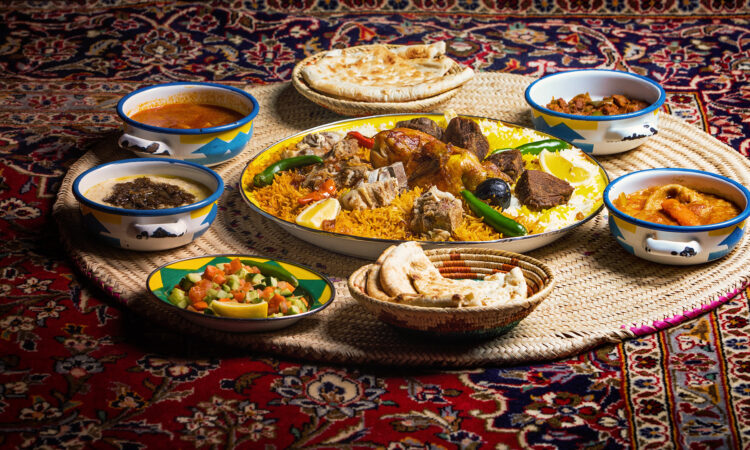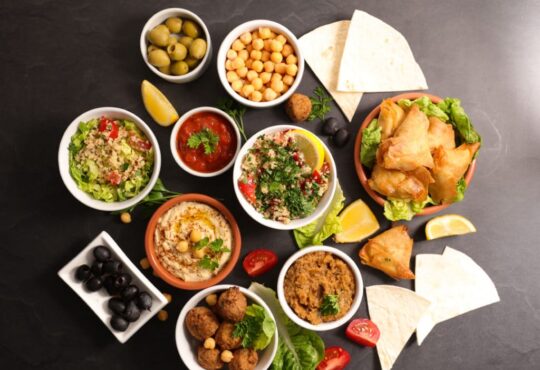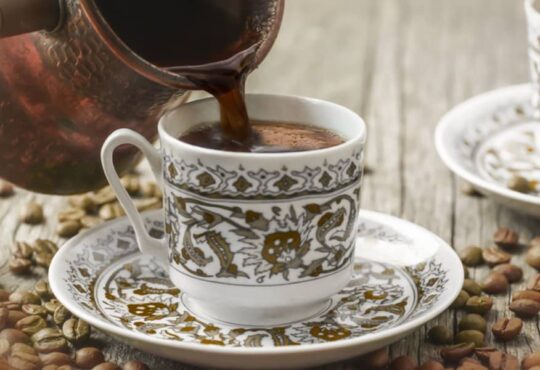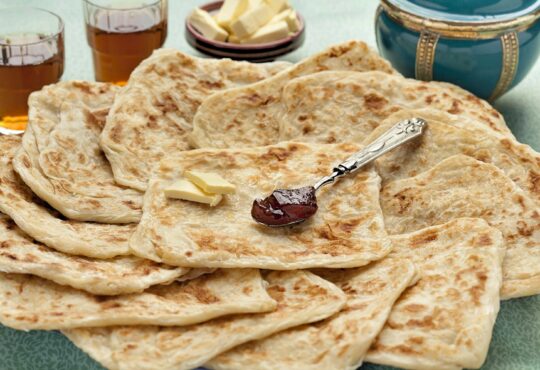
2.4K
Historically, Saudi Arabia’s food has been somewhat of an enigma. Not much is known about authentic olden-day Saudi food and most of the food that is now part of Saudi cuisine can be traced back to other countries in the region, like Egypt and Yemen.
When I first visited Saudi Arabia I was just bombarded with Kabsa. Chicken Kabsa; meat Kabsa; it was overwhelming. However, there is more to Saudi Arabian cuisine and food than just meat and rice.
This post is intended to shed light on some of the famous and other hidden dishes in Saudi Arabia.
Traditional Food in Saudi Arabia
Kabsa is the staple food in Saudi Arabia. There are several variations, but the essence of Kabsa is some meat or chicken served with a load of rice and some sides. It is normal for people to eat Kabsa daily for lunch and dinner. I would say that it is the most common Saudi Arabian food.
It is served on all occasions. It is like a mixture of everything, rice, meat, onions, and some other veggies and spices. It is consumed by the rich and the poor alike.
Chicken Kabsa can be a reasonably cheap dish since people can order one big Kabsa and split it between 4 people. The dish is generally eaten with one’s fingers but it’s okay to use a fork or spoon if you prefer.
Kabsa is not ideally a one-man meal. It’s a meal shared, divided, and enjoyed between friends and family. It’s another way for people to bond through food.
The reason why the Arabic flatbread (Khobz) is featured in the main dishes section is that the Khobz is literally served with everything. From breakfast to lunch and dinner main dishes, Arabic bread is always on the table.
The Saudi Arabic break is usually round and thin like in the picture below. The two-layered flatbread is made of wheat flour, yeast, and water salt, and cooked in a traditional or normal oven.
Harees is a unique Saudi Arabian dish that is made from ground wheat, meat, and some spices.
In Saudi Arabia, this porridge-like meat dish also includes tomatoes, peppers, and spices like cardamom and is drizzled with parsley over the top.
Some say that Harees is prepared during the month of Ramadan and shared with those who are less fortunate.
Saleeg is rice cooked in a milky broth, topped with meat or chicken. Common in the Hijaz region and a specialty in Taif, Saleeg is also spiced with fat, cardamom, and Arabic gum.
Sayadiya is a rare fish dish that is baked together with rice and vegetables in Jeddah. It is originally an Egyptian dish, commonly cooked in the Red Sea region.
One of the popular main dishes in the Najd (Riyadh) region in Saudi Arabia is Gursan. Traditional Gursan is prepared at home. The meat, chicken, and vegetables are all cooked together to provide a flavorsome stew.
Then the rice is prepared and served with the stew. Gursan sounds similar to the national food of Saudi Arabia, Kabsa but the difference is the preparation and the ingredients as Kabsa does not contain as many vegetables as Gursan does.
Foul is a common breakfast meal, served across the Kingdom of Saudi Arabia, foul (mashed beans) has reserved its place in iftar meals for decades.
Foul is served next to dates in every iftar meal across the region, and it is mainly bought from shops. Foul is also a popular dish at Yemeni breakfast restaurants. It is the most common breakfast in Saudi Arabia.
Another must-try food in Saudi Arabia is samosa (dough traditionally filled with meat and onions). Samosa is a triangle-shaped spiced savory, commonly served as a snack or in Ramadan.
It is not unique to Saudi Arabia but is spread across the Middle-east and Asian regions.
Due to the important role of the camel in Arab society, it is no surprise that the most loved and cherished meat in Saudi Arabia is camel meat.
It is said to be natural and very healthy. It is not consumed very often because it is more expensive than beef. If you are not a meat lover, you may find the smell and look of camel meat a bit strange.
This delightful bread is widely available all over Saudi Arabia. It is a relative of Afghani naan, a thick round bread that is freshly rolled by hand and baked in a traditional oven. Usually served with foul or Adas (lentils), Tamees, sometimes called Tameez is affordable and loved by all.
This savory snack is commonly served in Yemeni restaurants in Saudi Arabia, suggesting that it comes from Yemen.
Mutabbaq is a lightly filled pan-fried bread, similar to the Indian Parata or the Turkish Gozleme. it is usually filled with eggs, meat, onions, and some spices.
When freshly made, Mutabbaq can be a delicious meal on its own too.
Hineni is a tasty dessert that is made of a combination of crushed dates and crumbled bread. It is also routinely served with cream and sweetened with honey, condensed milk, and drizzled with almonds.
This treat can be enjoyed during breakfast or as an after-dinner sweet.
Ma’amoul is a famous dated centered biscuit or cookie. It is made from semolina or regular flour and comes in many varieties.
It is commonly served during special occasions, celebrations, and sometimes on regular days. It is best enjoyed fresh but can also be bought from your local grocery store.
Basbousa is a famous Egyptian cake or sweet that has made its way all over the Middle-east and even as far as Greece, Turkey, and Armenia. It is basically a semolina-based cake with coconut that is soaked in syrup.
It is a really sweet treat but I don’t think you want to have too much of it. A similar variety is the Turkish treat Revani.
Another famous Egyptian desert, Umm Ali is dubbed the national sweet of Egypt. The name, which means Ali’s mother, is also kind of interesting.
This tasty bread pudding is usually topped with nuts and raisins, cream, and burned at the top, making it look just as good as it tastes. Umm Ali is really loved all over Saudi Arabia.
Cardamom and rosewater-flavored cookie, sometimes with coconut, is especially famous in the famous northern regions of Saudi Arabia. I’m talking about Qassim and Ha’il. It is said that in Qassim Kleeja is an important part of their wedding ceremony.
Another great Yemeni invention that is common in Saudi Arabia is Masoub. It is described as a whole-wheat bread banana pudding. It usually includes nuts, honey, raisins, cream, and even cream cheese at times. It is really a sweet and yummy treat.
What’s less well-known about Saudi Arabia is that the country also has a thriving street food culture. While most Westerners are used to eating at restaurants, in Saudi Arabia, it’s common to buy food from street vendors instead.
The food on offer is cheap and tasty and ranges from kebabs to Shawarma wraps. So if you’re visiting Saudi Arabia, be sure to check out the country’s street food scene!
If you ever find yourself hungry in Saudi Arabia in the morning then you should seek out your nearest Yemeni breakfast spot. These spots are generally open in the morning only because they specialize in providing a fully loaded breakfast.
A Yemeni breakfast includes foul, shakshouka, or Lahsa (eggs), stir-fried chicken strips with onions and peppers, Kibda (fresh liver), and all of this is enjoyed with Yemeni bread.
The perfect drink to wash down this major munch is a ‘Shai Adeni’ which means Aden tea, named after a region in Yemen. This tea is spicy, sweet, and served with hot milk, similar to the Karak, below.
This fried chicken fast-food franchise is by far the most loved in all of Saudi Arabia, especially by the youth and working-class employees.
The brands were previously only available in the Hijaz region, which greatly upped their demand. It was so sought after that people would drive 100s of kilometers from Riyadh to Jeddah, fill their cars with Albaik and then return to Riyadh to re-sell it on the street for a profit. I found this really amazing.
In 2017, Al Baik finally opened its first stores in the central Riyadh region, in the quiet southern city of Al Kharj. Amazingly, the city of Kharj had quickly become overcrowded with youth from Riyadh city and elsewhere who couldn’t wait to get their hands on Albaik.
A staple in The Sham region (Syria-Jordan), falafel is another sought-after treat in Saudi Arabia. It can be served on its own or rolled into a shawarma wrap mixed with salad and sauce. Some see it as a quick and tasty alternative to meat.
Shawarma is the epitome of Middle-eastern street food. It can be eaten as the first and last meal of the day.
No matter where you are, you can always get a freshly cut and rolled shawarma wrap in any city, town, or village in Saudi Arabia.
Chicken shawarma is a staple for students in Saudi Arabia. It is a great meal for anyone who needs a quick meal on a budget.
An exotic and unique brand of coffee, Arabic coffee looks, smells, and tastes like no other. You either love it or hate it, with no middle ground in between.
However, if you spend a considerable amount of time in Saudi Arabia, you’d best learn to love it, as you will have to get used to accepting it wherever you go.
It is seen as the most basic symbol of Saudi Arabian hospitality. It is served in businesses, cafes, homes, on the streets, at companies, hotel lobbies and the list goes on…
Camel milk has been an enduring lifeline for the bedouins for millennia. It has at times, been the sole source of sustenance for the people of the desert.
It is believed to be extremely healthy and a cure for diseases and ailments. Current research shows that camel milk is a great source of protein, fat, and vitamins.
The Karak chai is a descendant of the Indo-Pakistani masala chai (tea). It is a strongly brewed tea made from loose tea leaves. Its taste is elevated by the addition of cardamom, and bags of sugar ( I really mean bags. It is sweet as hell) and the final touch is to use evaporated milk.
Which one of these foods have you tried in Saudi Arabia? Is our Saudi Arabia food bucket list missing a dish that we need to try on our next trip? Please let us know in the comments below!
Suggested reads:
The Hijaz region of Saudi Arabia has retained religious and political significance due to the presence of the two holy cities of Makkah and Madinah. Thus, this region has had a constant flow of people flowing through its regions, especially during the annual pilgrimage known as Hajj.
Haj has been an international Islamic gathering that unites Muslims from all over the world for 5 days. During this time people would live together, pray together, and eat together. Thus, the cultural exchange between travelers and locals has had a strong impact on Saudi Arabian food.
Another impact that has influenced the food in Saudi Arabia has been the movement of different peoples, especially from other Middle-eastern and Asian countries, to Saudi Arabia. Therefore, as a whole, one can see traces of Turkish, Syrian, Yemeni, Egyptian, Sudanese, Afghani, Persian, and even Indian influences in the food of Saudi Arabia.
Kabsa is the most popular food in Saudi Arabia and is widely available across the country hence it is considered the national dish in Saudi Arabia.
Saudi Arabian food is mostly known for the use of rice and meat. Some of the common food items in Saudi Arabian cuisine include wheat, rice, lamb, chicken, yogurt, potatoes, seafood, and dates.
Saudi Arabia offers both cheap and expensive food and it depends on your choice of restaurants. However, you can easily find cheap meals in Saudi Arabia. Just don’t go to fancy restaurants.
No, it is prohibited to eat pork in Saudi Arabia.
No, it is prohibited to drink or bring alcohol into Saudi Arabia.
Was this post useful? Support my work by sharing it on Pinterest and other social media platforms





